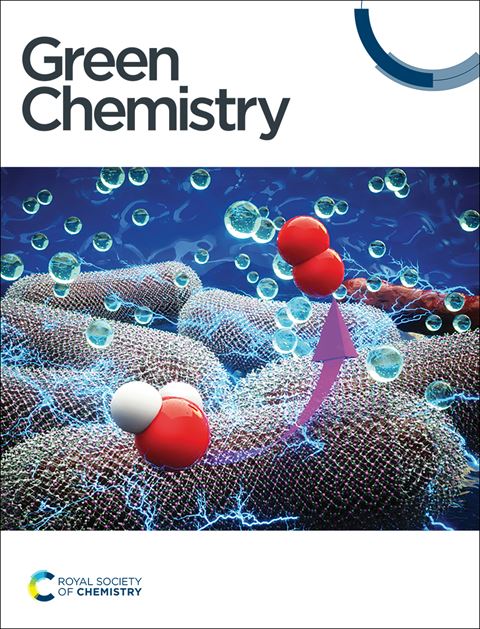A mediator-free enzyme carbonaceous cathode for bioelectrocatalytic reduction of furfural to furfuryl alcohol†
IF 9.3
1区 化学
Q1 CHEMISTRY, MULTIDISCIPLINARY
引用次数: 0
Abstract
The valorisation of biomass derivatives into fine chemicals through the combination of electro-enzymatic catalysis under green chemistry principles holds promising potential. However, bottlenecks, including poor electron transfer efficiency between the electrode surface and electron mediators, inefficient cofactor regeneration, and the high cost of enzymes and electron mediators, continue to hinder practical applications. Herein, to address the abovementioned technical barriers, we proposed an electron mediator-free bioelectrocatalytic system that integrated electrochemical NADH regeneration and enzymatic reactions. The proposed system was based on a novel, orderly assembled composite bioelectrode composed of a conjugated structure of covalent organic frameworks (COFs, namely, TpBD), which encapsulated cofactor-dependent oxidoreductases. The as-prepared composite bioelectrode was further applied to the highly selective hydrogenation of furfural to furfuryl alcohol. Results indicated that the electron pathway involved in the TpBD conjugated structure guaranteed effective cofactor regeneration on the composite bioelectrode without the assistance of costly electron mediators, thereby promoting the enzymatic reduction of furfural. A high furfural conversion of 98.94% was realized, accompanied by remarkable furfuryl alcohol selectivity of 90.13% at −1.4 V (vs. Ag/AgCl). The novel composite bioelectrode also showed good stability and reusability. Up to 88.1% of the original furfuryl alcohol selectivity was preserved after 10 cycles of recycling. This work presents a promising green alternative route for the valorisation of furfural, with great potential for extending to the valorization of other renewable biomass derivatives.

求助全文
约1分钟内获得全文
求助全文
来源期刊

Green Chemistry
化学-化学综合
CiteScore
16.10
自引率
7.10%
发文量
677
审稿时长
1.4 months
期刊介绍:
Green Chemistry is a journal that provides a unique forum for the publication of innovative research on the development of alternative green and sustainable technologies. The scope of Green Chemistry is based on the definition proposed by Anastas and Warner (Green Chemistry: Theory and Practice, P T Anastas and J C Warner, Oxford University Press, Oxford, 1998), which defines green chemistry as the utilisation of a set of principles that reduces or eliminates the use or generation of hazardous substances in the design, manufacture and application of chemical products. Green Chemistry aims to reduce the environmental impact of the chemical enterprise by developing a technology base that is inherently non-toxic to living things and the environment. The journal welcomes submissions on all aspects of research relating to this endeavor and publishes original and significant cutting-edge research that is likely to be of wide general appeal. For a work to be published, it must present a significant advance in green chemistry, including a comparison with existing methods and a demonstration of advantages over those methods.
 求助内容:
求助内容: 应助结果提醒方式:
应助结果提醒方式:


